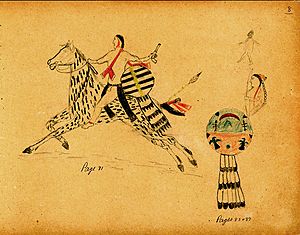Carl Sweezy facts for kids
Carl Sweezy (1881–1953) was a talented artist from the Southern Arapaho tribe in Oklahoma. He was known for painting pictures of people. But he was most famous for showing traditional ceremonies and dances in his art.
Contents
Carl Sweezy's Early Life
Carl Sweezy was born in 1881. His birthplace was near the Darlington Agency. This area was part of the Cheyenne and Arapaho Indian Reservation in what was then called Indian Territory. His Arapaho name was Wattan, which means "Black." Carl's father was named Hinan Ba Seth, meaning "Big Man." When Carl was a child, his tribe still hunted buffalo.
Carl's mother passed away when he was young. Because of this, he lived at the Mennonite Mission School. This school was also at the Darlington Agency. Later, he went to other schools. These included the Mennonite Boarding School in Halstead, Kansas. He also attended the Carlisle Indian Industrial School in Pennsylvania. Another school he went to was the Chilocco Indian Agricultural School in Oklahoma.
Carl Sweezy was a professional baseball player for a while. After that, he worked as a tribal policeman. He never went to a formal art school. However, he loved drawing and painting from a young age. An employee at the agency gave him watercolor paints. This encouraged his artistic talent.
His Amazing Artwork
Around 1895, when Carl Sweezy was about 14 years old, an expert named James Mooney asked him to paint. Mooney wanted pictures of traditional Arapaho life. Later, Sweezy also worked with another expert, George Dorsey. Carl Sweezy kept painting a lot. He used different art supplies and methods into the mid-1900s. By the 1920s, painting became his full-time job.
Sweezy used watercolors on paper. He also painted with oil on canvas. Sometimes, he even used house paint on wooden boards. He was one of the first art teachers for the Cheyenne artist Dick West. Carl Sweezy painted many individual portraits. But he is most famous for his paintings of ceremonies and dances. These often showed more than a dozen people. His paintings told a story and showed action.
Sweezy developed a special way of painting. He would show an active Native American Church meeting. He did this by painting the tipi flaps rolled up. This way, you could see the people inside. Other artists from the Southern Plains later used this same technique.
Where to See His Art
You can find Carl Sweezy's artwork in many public art collections. These include:
- Cleveland Museum of Natural History
- Fred Jones Jr. Museum of Art
- George Gustav Heye Center
- Gilcrease Museum
- Heard Museum
- Indian Arts and Crafts Board, United States Department of the Interior
- Oklahoma History Center
- National Museum of the American Indian, Washington DC
- Sam Noble Oklahoma Museum of Natural History
- Philbrook Museum of Art
- Southwest Museum of the American Indian, Los Angeles
- University of Oklahoma, Library
His Last Years
Carl Sweezy passed away on May 28, 1953. He died in Lawton, Oklahoma.
Carl Sweezy's Own Words
The corn road, we found, was different from the buffalo road in more ways than anyone, white or Indian, had realized, and the old people could not learn it in a hurry. —Carl Sweezy
With war horses running, feathers and banners flying on the wind from spears and lances, shields and quivers shining at men's sides and shoulders, and women singing war songs for their men, I think a war party setting out, or coming in victorious, must have been one of the splendid things in life to see. If I had to miss that, I have had the next best thing: I have seen old warriors wearing their fine trappings, and I have heard them tell their stories... –Carl Sweezy, 1950


